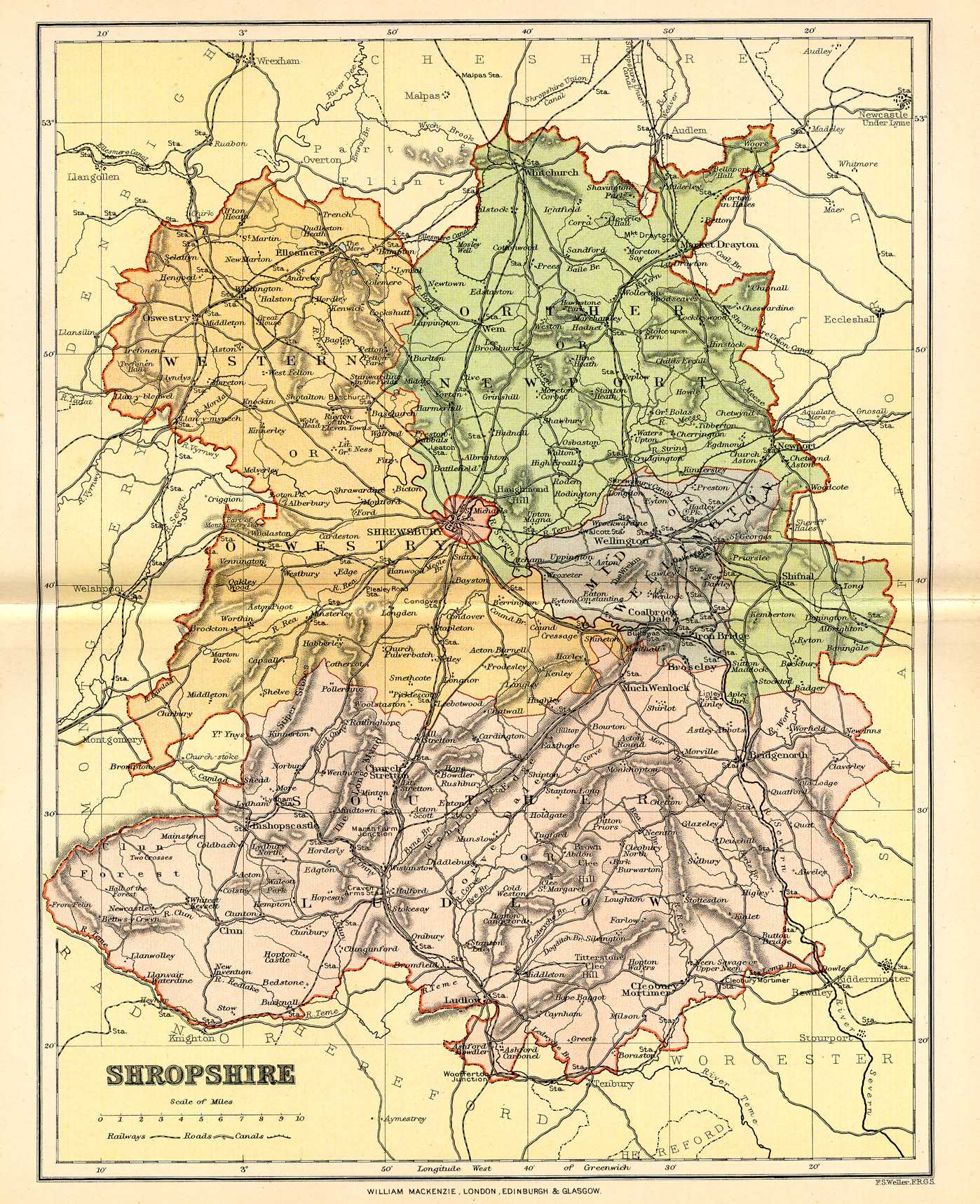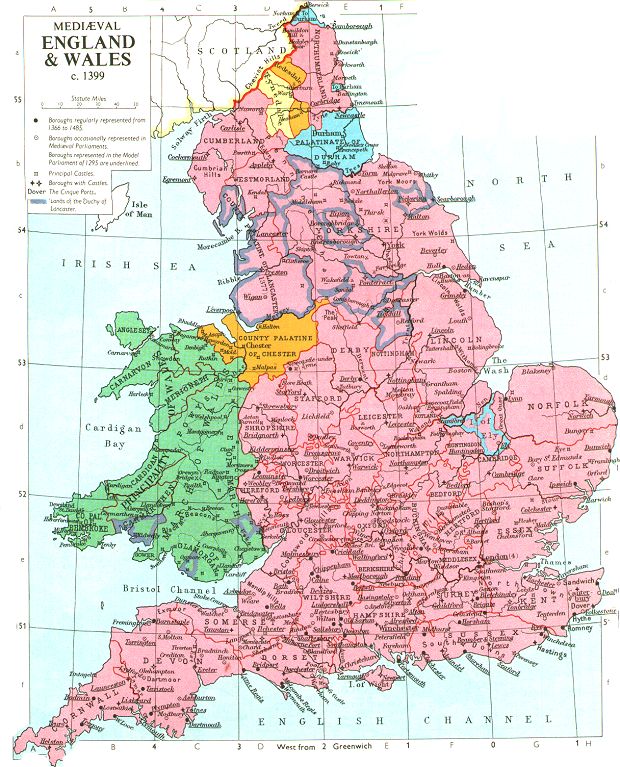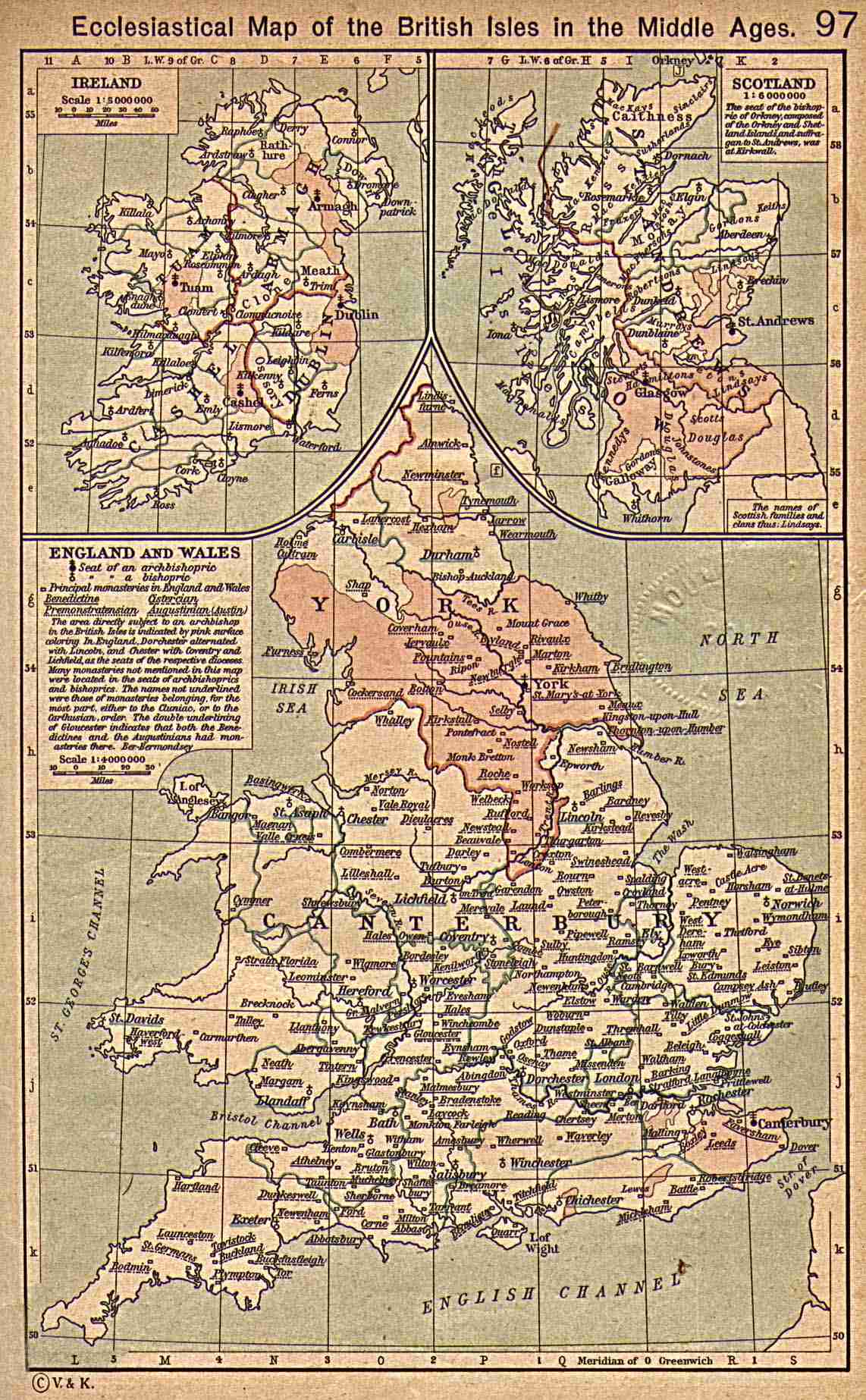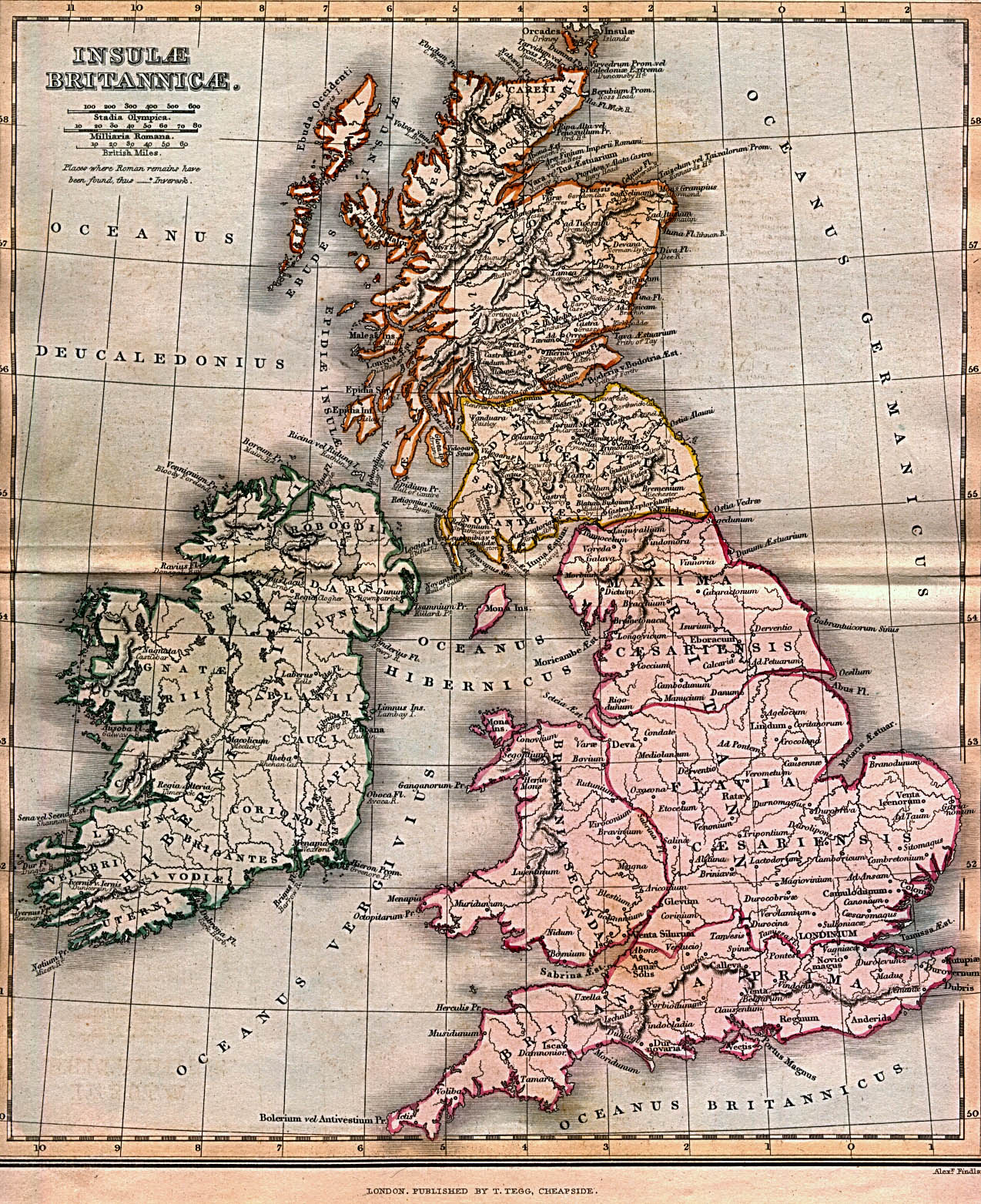The Setting
From Ars Magica
m (→Reigns of the Plantagenets) |
m (→The Church of the 12th-13th Century) |
||
| Line 82: | Line 82: | ||
| - | |||
| - | |||
| - | |||
| - | |||
| - | |||
| - | |||
| - | |||
| - | |||
| - | |||
| - | |||
| - | |||
| - | |||
| - | |||
| - | |||
| - | |||
| - | |||
| - | |||
| - | |||
| - | |||
| - | |||
| - | |||
| - | |||
| - | |||
| - | |||
| - | |||
| - | |||
| - | |||
| - | |||
| - | |||
| - | |||
| - | |||
| - | |||
| - | |||
| - | |||
| - | |||
| - | |||
| - | |||
| - | |||
| - | |||
| - | |||
| - | |||
| - | |||
| - | |||
| - | |||
| - | |||
| - | |||
| - | |||
| - | |||
| - | |||
| - | |||
| - | |||
| - | |||
| - | |||
| - | |||
| - | |||
| - | |||
| - | |||
| - | |||
| - | |||
| - | |||
| - | |||
| - | |||
| - | |||
| - | |||
| - | |||
| - | |||
| - | |||
| - | |||
| - | |||
| - | |||
| - | |||
| - | |||
| - | |||
| - | |||
| - | |||
| - | |||
| - | |||
| - | |||
| - | |||
| - | |||
| - | |||
| - | |||
| - | |||
| - | |||
| - | |||
| - | |||
| - | |||
| - | |||
| - | |||
| - | |||
| - | |||
| - | |||
| - | |||
| - | |||
| - | |||
| - | |||
| - | |||
| - | |||
| - | |||
| - | |||
| - | |||
| - | |||
| - | |||
| - | |||
| - | |||
| - | |||
| - | |||
| - | |||
| - | |||
| - | |||
| - | |||
| - | |||
| - | |||
| - | |||
| - | |||
| - | |||
| - | |||
| - | |||
| - | |||
| - | |||
| - | |||
| - | |||
| - | |||
| - | |||
| - | |||
| - | |||
| - | |||
| - | |||
| - | |||
| - | |||
| - | |||
| - | |||
| - | |||
| - | |||
| - | |||
| - | |||
| - | |||
| - | |||
| - | |||
| - | |||
| - | |||
| - | |||
| - | |||
| - | |||
| - | |||
| - | |||
| - | |||
| - | |||
| - | |||
| - | |||
| - | |||
| - | |||
| - | |||
| - | |||
| - | |||
| - | |||
| - | |||
| - | |||
| - | |||
| - | |||
| - | |||
| - | |||
| - | |||
| - | |||
| - | |||
| - | |||
| - | |||
| - | |||
== A medieval glossary == | == A medieval glossary == | ||
Revision as of 15:49, 12 March 2006
Contents |
Local Medieval History and Geography
Where are we?
The game begins with the players and their retinue arriving at an inn in the small hamlet of Church Stretton.
Little Stretton, Church Stretton, and All Stretton, are three small settlements that form the manor of Stretton-en-le-Dale. The central and largest settlement, where the church was built, is the small market town of Church Stretton, some 19 km. (12 miles/4 leagues). south-southwest of Shrewsbury and 20 km. (12 1/2 miles/4 leagues) north-north-west of Ludlow. The village is dominated by the huge Long Mynd massif, which provides Church Stretton with both its views, and good, fresh spring water.
All the settlements lie near, but not on, the Roman road from Deva (Chester) via Viroconium Cornoviorum (Wroxeter) to Isca (Caerleon, Mon.) The road, itself known as Botte (Bot) Street, gave a name to the three Strettons, All Stretton apparently taking its particular name from one Alfred, the nature of whose connection with the settlement is not known.
Between Little Stretton and Church Stretton lies Brockhurst Hill, upon which a modest castle has been newly constructed to watch over the roman road.
The Long Mynd, or 'Long Mountain', is a ridge of high ground in South Shropshire, running roughly SW to NE, and extending some 15 km. (9 miles/3 leagues) in length, between the Stiperstones to the west, and Wenlock Edge to the east. The rock is pre-Cambrian, though not as old as the volcanic rock of the Stretton hills (Lawley, Caradoc and Ragleth) to the east. The highest point is Pole Bank, 516m. (1693 ft.) above sea level. An ancient track, the Portway, runs along the top of the ridge.
Geological Information about Church Stretton
The parish's geology is almost entirely PreCambrian. The principal feature is the Church Stretton Fault running along the east side of the dale. East of the fault, broadly speaking, the hills are formed of what, apart from some small areas of schists near the Wrekin, are Shropshire's oldest rocks, the Uriconian volcanics: mainly Ragleth Tuffs, though Caer Caradoc's geology is complicated by Caer Caradoc Andesites and Cwms Rhyolites with intrusive igneous Dolerite. West of the fault the younger Longmyndian sedimentary rocks from the Long Mynd, their strata dipping almost vertically to the northwest, throwing up the Stretton Series of fine-grained siltstones and a thin band of Cardingmill Grit and, further west and beyond the parish boundary, the newer coarse-grained Wentnor Series; the higher parts of the Long Mynd are covered with head and, between All Stretton and Colliers Lye, areas of boulder clay. In the centre of the dale Longmyndian rocks are exposed on both sides of the fault so that Stretton Shales from the lowest slopes not only of the Long Mynd but also of Ragleth and Helmeth hills and the south-western slope of Caer Caradoc hill; on the western slopes of the eastern hills, though not on the Long Mynd, Helmeth Grit, oldest of the Longmyndian rocks, appears from beneath the Stretton Shales. Small areas at the south end of Ragleth hill (around Wiresytch coppice) and at the eastern end of Minton township (around Queensbatch mill and Marshbrook) are Ordovician: Caradoc shales, flags, and sandstone. The floor of the dale consists of glacial deposits of boulder clay overlying Silurian shales and limestone; some of those shales, of the Llandovery and Wenlock Series, are exposed in the southern part of the dale, particularly around Minton. There are alluvial deposits along the courses of the streams and, here and there, islands of sand and gravel. Coal Measures have been encountered near Botvyle.
From: 'Church Stretton', A History of the County of Shropshire: Volume 10: Munslow Hundred (part), The Liberty and Borough of Wenlock (1998), pp. 72-120. URL: http://british.history.ac.uk/report.asp?compid=22861. Date accessed: 26 January 2006.
Shrewsbury
- Shrewsbury/Shewsbury/Shrewesbury/Sarop/Salop is the nearest major town to the player's starting location.
The County of Shropshire
The History of Shropshire
History of Shropshire from the 1911 Encyclopaedia Britanica
Locations in Shropshire
Information garnered from various modern sources about the area of the time of the campaign.
Acton,
Acton Castle,
All Stretton,
Bishop's Castle,
Brockhurst Castle,
Cheyney Longville,
Clun,
Clun Castle,
Craven Arms,
Church Stretton,
Little Stretton,
Long Mynd,
Ludlow,
Ludlow Castle,
Much Wenlock,
Newton,
Norton Camp,
Shrewsbury,
Shrewsbury Castle,
Stokesay Castle,
Wenlock Edge,
Wistanstow,
Edit the Template:Gazeteer
Maps of Shropshire
Immediate area around Church Stretton
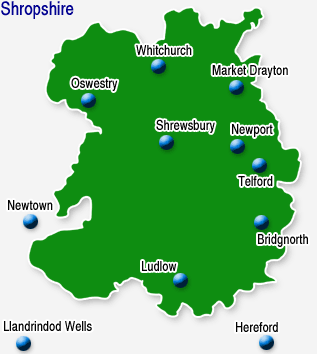
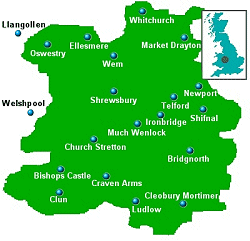
This page has a selection of maps, as a basis for discussions about the location of the game. Some maps show castle locations (where there are castles, there are bothersome nobles), roads (nosy passersby), roman-latin nomenclature, etc.
A map of just Shropshire, showing Shrewsbury and the Strettons
Maps of all or part of Britain
Click on the following thumbnails for full-size versions. The largest files will present you with an intermediate-size thumbnail, and the option of downloading the very high resolution version of the picture.
English Medieval History
A medieval glossary
This is a short list of some of the terms used in the Cadfael stories and their meanings.
- Alltud - This is the name given to a foreigner who lives in Wales.
- Arbalest - A crossbow with a winding apparatus to enable the bow to be drawn.
- Baldric - The belt which crossed the chest from the shoulder to the hip and used to support a sword.
- Bannerole - A thin ribbon which was attached to the tip of a lance or long spike.
- Bodice - The upper part of a woman's dress, or a top worn by the woman over a blouse.
- Brychan - A blanket made of home spun wool.
- Caltrop - A small iron weapon. Made up of four spikes set so that however it was laid on the ground, one spike always pointed upwards. Used against horses and infantry.
- Capuchon - A hood, similar to a cowl which wrapped around the wearer's neck.
- Cariad - Welsh for beloved.
- Cassock - Long garment, used by monks.
- Castellan - The name given to the ruler of a castle.
- Chatelaine - The lady of a manor house.
- Chausses - Worn by medieval men on the legs, similar to tights.
- Coif - Cap worn by nuns under their veils.
- Conversus - A man who joins the monkhood after living in the outside world.
- Cottar - A Villein who is given a cottage in return for his work.
- Cotte - A medieval coat usually full length of knee length depending on class.
- Croft - A piece of pasture land next to a house.
- Currier - A comb for grooming a horse.
- Demesne - Any land retained by a lord for his own use.
- Diocese - A district which contains a cathedral.
- Dortoir - The monks sleeping area.
- Electuary - Medicinal powder which is mixed with honey to be taken orally.
- Eremite - A religious hermit.
- Espringale - A military machine like a large crossbow.
- Frater - The monk's common dining room.
- Garderobe - A medieval lavatory. Shafts cut through the thickness of the wall.
- Garth - The grassy quadrangle within the monastic cloisters.
- Geneth - Welsh for girl.
- Gentle - A person from an honorable family.
- Glebe - An area of land owned by a clergyman whilst in office.
- Grange - The lands and buildings of an outlying farm which belongs to a monastery.
- Groat - A small coin
- Gruel - Thin watery or milky porridge, usually fed to invalids.
- Guild - An association of tradesmen, formed to protect its members interests and to maintain standards.
- Gyve - An iron shackle, usually for the leg.
- Hauberk - A chainmail coat, originally to defend the neck and shoulders.
- Helm - The medieval helmet.
- Horarium - The monastic timetable, divided into canonical hours, or offices, of Matins, Lauds, Prime, Terce, Sext, None, Vespers and Compline.
- Husbandman - A tenant farmer.
- Jess - A short strap attached around a hawk's leg in falconry.
- Largesse - Money or gifts, bestowed freely by an important person on a great occasion.
- Leat (Leet) - An artificial waterway, used to divert water for use in a mill, etc.
- Litany - A series of phrases or prayers recited alternately by clergyman and congregation.
- Llys - The name given to the royal court of Welsh princes. All buildings of the Llys were made of timber.
- Lodestar - A star forming a fixed point of reference, such as the Pole Star.
- Lodestone - A magnetized piece of metal ore.
- Lye - A strong alkaline solution used for washing, cleaning and making soap.
- Mandora - An ancient stringed instrument, Ancestor of the mandolin.
- Mangonel - A military machine used for hurling bolts, stones and other missiles.
- Marl - Soil consisting of clay and lime and valuable as a fertiliser.
- Messuage - A house with its adjoining land and out-buildings, usually rented.
- Midden - Dung heap.
- Missal - A prayer book, containing all the services for celebrating Mass throughout the year.
- Moneyer - A minter of coins.
- Mountebank - A trickster or an entertainer.
- Mullion - The upright post dividing the lights in a window.
- Mummer - An actor or player in a traditional, usually religious, mime or masque.
- Murage - The tax levied to pay for building or repair to the walls of a town.
- Murrain - An infectious disease in cattle.
- Myrmidon - A faithful servant who carries out orders without question.
- Nacre - Mother of pearl.
- Oblatus - A monk who had been placed in the monastery from a very young age and therefore, had little experience of the outside world.
- Orts - Waste food or scraps.
- Ostler - A person who takes charge of horses.
- Palfrey - A saddled horse for a woman.
- Pallet - A narrow wooden bed or a straw-filled mattress.
- Palliative - A pain killer.
- Pannikin - A small metal cup or saucepan.
- Parfytours - Hunting hounds.
- Parole - The word of honour given by a prisoner that they would not escape if released from prison.
- Patten - A wooden sandal.
- Pavage - The tax levied to pay for the paving of streets.
- Penteulu - The Welsh rank of captain of the royal guard.
- Pommel - The upward pointing front part of a saddle.
- Poniard - A dagger.
- Prelate - An abbot, bishop or other high ranking member of the church.
- Prie-Dieu - The kneeling desk used for prayer.
- Pyx - A small box or casket, usually to contain the consecrated bread.
- Quintain - A target mounted on a post and tilted at by a horseman.
- Rebec - A three stringed instrument, played with a bow.
- Rheum - A watery discharge from the nose or eyes.
- Saeson - An Englishman.
- Scabbard - The sheath of a dagger or sword.
- Sconce - The wall bracket which held a candle or torch.
- Sheepfold - The enclosure for penning in sheep.
- Shriven - Someone who has received confession and has been absolved.
- Shut - A small alleyway running between the main streets of the town.
- Skiff - An open flat bottomed rowing boat.
- Sow - A long structure which was used to cover and protect a battery of men who were charging or ramming the walls of a fortress.
- Springe - A sprung noose used to snare small game.
- Stoup - A tankard or other drinking vessel.
- Sumpter - A pack horse.
- Synod - A council or assembly of bishops and other church officials.
- Tallow - Animal and vegetable fat used to make candles or soap.
- Timbrel - An instrument, similar to a tambourine.
- Tithe - The tax on labour and produce from the land used to support the clergy, usually 10%.
- Torsin - An alarm bell.
- Toper - A heavy drinker or drunkard.
- Touchstone - A heavy black stone, usually jasper or basalt, used to test the quality of gold or silver.
- Trencher - A wooden platter used for food.
- Troche - A small medicinal lozenge.
- Uchelwr - The nearest Welsh equivalent to an English nobleman.
- Vassal - The holder of a small plot of land from a lord. In return for his services, he received protection from the lord.
- Villein - A serf or tenant bound to the land and subject to the control of a lord. He was above the status of a slave, but could not marry without his lord's consent.
- Virelai - A short French poem.
- Vittles - Food and provisions to be used for human consumption.
- Votary - A person bound by vows to follow a certain way of life, usually religious.
- Wattle - Sticks interlaced with twigs and branches and used to build huts and fences.
- Wicket - A small door or gate built in or beside a larger door.
- Wimple - A linen or silk cloth folded round the head and wrapped under the chin. Worn by women especially wives and nuns.
- Yeoman - A respectable freeman, usually a farmer with the status of just below a gentleman. He could vote in county elections.
